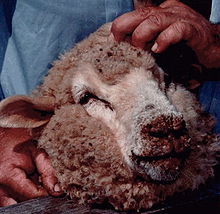- Orf (disease)
-
Orf (disease) Classification and external resources 
A thumb with two denuded orf lesions, following a bite by a sheepICD-10 B08.0 (ILDS B08.040) ICD-9 051.2 DiseasesDB 9262 eMedicine article/1133450 MeSH D004474 Orf virus 
Virus classification Group: Group I (dsDNA) Family: Poxviridae Genus: Parapoxvirus Species: Orf virus Orf is an exanthemous disease caused by a parapox virus and occurring primarily in sheep and goats. It is also known as contagious pustular dermatitis, infectious labial dermatitis, ecthyma contagiosum, and sheep pox[1]:393, thistle disease[2] and scabby mouth. Orf virus is zoonotic - it can also infect humans.[2]
Contents
In humans
Orf is a zoonotic disease, meaning humans can contract this disorder through direct contact with infected sheep and goats or with fomites carrying the orf virus. It causes a purulent-appearing papule locally and generally no systemic symptoms. Infected locations can include the finger, hand, arm, face and even the penis (caused by infection from the hand during urination). Consequently it is important to observe good personal hygiene and to wear gloves when treating infected animals.[2] The papule may persist for 7 to 10 weeks and spontaneously resolves. It is an uncommon condition and not easily identified by most doctors. This affliction can be contagious (passed from one human to another).
While orf is usually a benign self-limiting illness, it can be very progressive and even life-threatening in the immune-compromised host. One percent topical cidofovir has been successfully used in a few patients with progressive disease. Serious damage may be inflicted on the eye if it is infected by orf, even among healthy individuals. The virus can survive in the soil for at least six months.[3]
In sheep and goats
It has been recorded since the late 19th century and has been reported from most sheep- or goat-raising areas including those in Europe, the Middle East, the United States, Africa, Asia, Alaska, South America, Canada, New Zealand and Australia.[3] Orf is spread by fomites and direct contact. In some environments infection is injected by scratches from thistles[2] of both growing and felled plants. Symptoms include papules and pustules on the lips and muzzle, and less commonly in the mouth of young lambs and on the eyelids, feet, and teats of ewes. The lesions progress to thick crusts which may bleed. Orf in the mouths of lambs may prevent suckling and cause weight loss, and can infect the udder of the mother ewe, thus potentially leading to mastitis.[2] Sheep are prone to reinfection.[4] Occasionally the infection can be extensive and persistent if the animal does not produce an immune response.[2]
A live virus vaccine (ATCvet code: QI04AD01) is made from scab material and usually given to ewes at the age of two months, but only to lambs when there is an outbreak.[5] The vaccine can cause disease in humans.
In sheep and goats the lesions mostly appear on or near the hairline and elsewhere on the lips and muzzle. In some cases the lesions appear on and in the nostrils, around the eyes, on the thigh, coronet, vulva, udder and axilla. In rare cases, mostly involving young lambs, lesions are found on the tongue, gums, roof of the mouth and the oesophagus. It has also been reported a number of times to cause lesions in the rumen. In one case it was shown that a severe form of orf virus caused an outbreak involving the gastrointestinal tract, lungs, heart, as well as the buccal cavity, cheeks, tongue and lips. Another severe case was reported pharyngitis, genital lesions and infection of the hooves which led to lameness and, in some cases, sloughing of the hoof.[3]
More typically sheep will cure themselves of orf within a week or so as the disease runs its course. Sheep custodians can assist by applying antibiotic sprays on to large scabs, ensuring infected lambs receive sufficient milk and separating out the infected stock to slow down cross-transmission to healthy animals. It is advisable for those handling infected animals to wear disposable gloves to prevent cross-infection and self-infection. Vets need to be contacted if there is a risk of misdiagnosis with other, more serious conditions.[2]
In other animals
Primarily, orf is a disease of sheep and goats although it has been reported as a natural disease in the following: humans, steenbok and alpacas, chamois and thar, reindeer, musk ox, the dog, the cat, the mountain goat, bighorn sheep, dall sheep, and the red squirrel .[3]
See also
References
- ^ James, William D.; Berger, Timothy G.; et al. (2006). Andrews' Diseases of the Skin: clinical Dermatology. Saunders Elsevier. ISBN 0-7216-2921-0.
- ^ a b c d e f g Winter, Agnes; Charmley, Judith (1999). The Sheep Keeper's Veterinary Handbook. Crowood Press Ltd (Marlborough, UK). ISBN 1-86126-235-3.
- ^ a b c d Couch, Alan John; (1983). "The Development of, and Host Response to, Ovine Contagious Pustular Dermatitis". A thesis submitted to the Faculty of Science of the University of New England, Armidale, N.S.W., in partial fulfilment of the requirements of the degree of Bachelor of Science with Honours. http://members.pcug.org.au/~acouch/cpd.pdf. Retrieved 2008-08-22.
- ^ Fenner, Frank J.; Gibbs, E. Paul J.; Murphy, Frederick A.; Rott, Rudolph; Studdert, Michael J.; White, David O. (1993). Veterinary Virology (2nd ed.). Academic Press, Inc. ISBN 0-12-253056-X.
- ^ Carter, G.R.; Wise, D.J. (2006). "Poxviridae". A Concise Review of Veterinary Virology. http://www.ivis.org/advances/Carter/Part2Chap10/chapter.asp?LA=1. Retrieved 2006-06-13.
Infectious skin disease: Viral cutaneous conditions, including viral exanthema (B00–B09, 050–059) HSV (Herpes simplex, Herpetic whitlow, Herpes gladiatorum, Herpetic keratoconjunctivitis, Herpetic sycosis, Neonatal herpes simplex, Herpes genitalis, Herpes labialis, Eczema herpeticum, Herpetiform esophagitis) · Herpes B virus (B virus infection)VZV (Chickenpox, Herpes zoster, Herpes zoster oticus, Ophthalmic zoster, Disseminated herpes zoster, Zoster-associated pain, Inflammatory skin lesions following zoster infection, Modified varicella-like syndrome)SealpoxOtherPapillomaviridaeHPV (Wart/Plantar wart, Heck's disease, Genital wart (giant), Laryngeal papillomatosis, Butcher's wart, Bowenoid papulosis, Epidermodysplasia verruciformis, Verruca plana, Pigmented wart, Verrucae palmares et plantares )
BPV (Equine sarcoid)Parvovirus B19 (Erythema infectiosum, Reticulocytopenia, Papular purpuric gloves and socks syndrome)CAV (Hand, foot and mouth disease, Herpangina) · FMDV (Foot-and-mouth disease) · Boston exanthem diseaseUngrouped unknown/multiple: Asymmetric periflexural exanthem of childhood · Post-vaccination follicular eruption · Lipschütz ulcer · Eruptive pseudoangiomatosis · Viral-associated trichodysplasia · Gianotti–Crosti syndromeCategories:- Sheep and goat diseases
- Poxviruses
- Animal virology
- Virus-related cutaneous conditions
Wikimedia Foundation. 2010.

